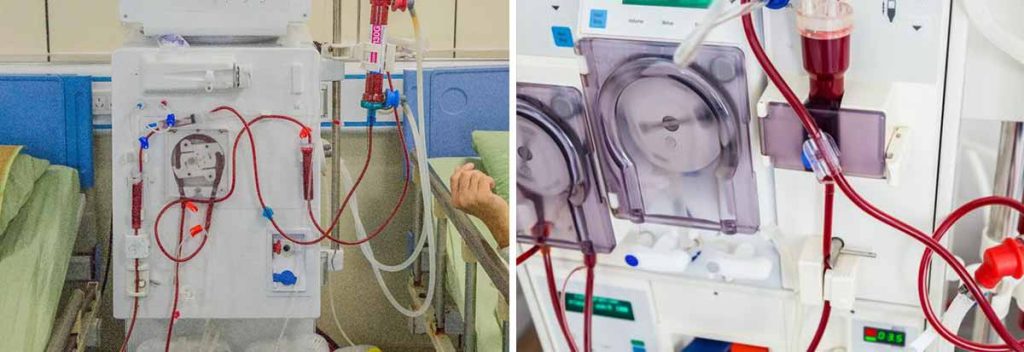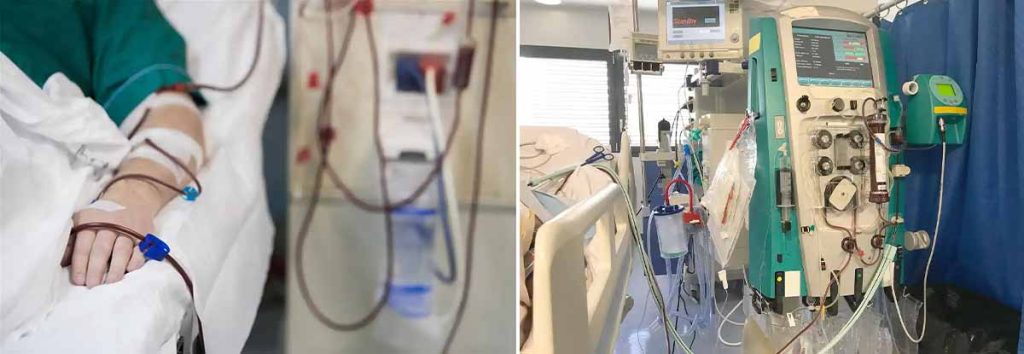

High level disinfectants play a vital role in dialysis by ensuring the sterility of equipment and reducing infection risks. Substances like glutaraldehyde, hydrogen peroxide, and peracetic acid are widely used due to their proven effectiveness. For instance, studies reveal that hydrogen peroxide and peracetic acid suppress biofilm formation, a common issue in dialysis. Glutaraldehyde, recognized by the CDC, is another reliable option. Its noncorrosive nature and ability to eliminate various microorganisms make it a preferred sterilant for medical equipment. Proper handling of these disinfectants ensures safe and effective dialysis procedures.
Key Takeaways
- Strong disinfectants like glutaraldehyde, hydrogen peroxide, and peracetic acid keep dialysis tools clean.
- Glutaraldehyde kills many germs and does not harm delicate devices.
- Hydrogen peroxide stops slimy layers (biofilm) that can cause infections, keeping dialysis safer.
- Peracetic acid works well with heat-sensitive tools and kills germs, even with dirt around.
- Workers need training and must follow safety rules to use these disinfectants safely and protect patients.
Common High-Level Disinfectants in Dialysis
Glutaraldehyde
Properties and Effectiveness
Glutaraldehyde is a widely recognized high level disinfectant used in dialysis. Its effectiveness stems from its ability to kill a broad spectrum of microorganisms, including bacteria, fungi, and viruses. At a concentration of 2%, it can eliminate vegetative bacteria in under two minutes and spores of Bacillus species within three hours. This makes it a reliable option for disinfecting medical equipment. The CDC endorses glutaraldehyde for its noncorrosive properties, ensuring that it does not damage sensitive dialysis equipment.
| Concentration | Contact Time | Microorganisms Killed |
|---|---|---|
| ≥2% | <2 minutes | Vegetative bacteria |
| ≥2% | <10 minutes | M. tuberculosis, fungi, viruses |
| ≥2% | 3 hours | Spores of Bacillus and Clostridium |
| 2% | Rapidly | Spores of C. difficile |
Usage in Dialysis Settings
In dialysis, glutaraldehyde is commonly used to disinfect reusable components such as dialyzers. Its rapid action and compatibility with medical-grade materials make it a preferred choice. However, proper handling is essential due to its potential toxicity. Healthcare workers must follow strict safety protocols to ensure its safe application.
Hydrogen Peroxide
Mechanism of Action
Hydrogen peroxide acts by releasing reactive oxygen species, which disrupt the cellular structures of microorganisms. This mechanism allows it to effectively target bacteria, fungi, and viruses. When combined with peracetic acid, it enhances its antimicrobial activity, making it suitable for dialysis environments.
Benefits and Limitations
Hydrogen peroxide offers several advantages, including its ability to suppress biofilm formation. Studies show that it effectively combats biofilms formed by Candida species at concentrations below 0.3%. Additionally, its use in Brazil for reprocessing dialyzers highlights its global applicability. However, its effectiveness can diminish in the presence of organic matter, requiring careful application.
| Year | Percentage of Dialysis Centers Using Disinfectant |
|---|---|
| 1983 | 5% |
| 1997 | 72% |
Peracetic Acid
Compatibility with Dialysis Equipment
Peracetic acid is highly compatible with dialysis equipment due to its noncorrosive nature. It can sterilize heat-sensitive devices that cannot withstand traditional methods. Clinical trials confirm its effectiveness in real-world settings, where it has shown excellent microbicidal activity.
Antimicrobial Activity

This high level disinfectant demonstrates remarkable antimicrobial properties. At concentrations of 200 to 500 ppm, it remains effective even in the presence of organic matter. It can inactivate gram-positive and gram-negative bacteria, fungi, and yeasts in under five minutes at concentrations below 100 ppm. Additionally, its combination with hydrogen peroxide inactivates glutaraldehyde-resistant mycobacteria, making it a versatile option for dialysis.
Peracetic acid has proven to be a reliable disinfectant in dialysis, with no clinical failures leading to infection reported during trials.
Alcavis 50
Fast-Acting Properties
Alcavis 50 is a high-level disinfectant known for its rapid action. It contains a stabilized combination of sodium hypochlorite and hypochlorous acid, which allows it to act quickly against a wide range of pathogens. This disinfectant can eliminate bacteria, viruses, and fungi within seconds to minutes, depending on the concentration and exposure time. Its fast-acting nature makes it particularly useful in dialysis settings, where equipment must be disinfected efficiently between uses. Healthcare facilities often rely on Alcavis 50 to maintain a sterile environment without compromising workflow efficiency.
Tip: Always follow the manufacturer’s guidelines for dilution and contact time to ensure optimal disinfection results.
Broad-Spectrum Effectiveness
Alcavis 50 demonstrates broad-spectrum antimicrobial activity. It effectively targets gram-positive and gram-negative bacteria, as well as resistant strains like Pseudomonas aeruginosa and Staphylococcus aureus. Its ability to combat biofilms further enhances its utility in dialysis, where biofilm formation can compromise equipment sterility. Additionally, Alcavis 50 is compatible with most dialysis materials, reducing the risk of equipment damage. This compatibility ensures that healthcare providers can use it confidently across various components, including dialyzers and tubing systems.
Chlorhexidine Gluconate
Long-Lasting Antimicrobial Effects
Chlorhexidine gluconate offers prolonged antimicrobial protection, making it a valuable disinfectant in dialysis. Its mechanism involves disrupting microbial cell membranes, which prevents the growth of bacteria, fungi, and viruses. Unlike some disinfectants that lose efficacy quickly, chlorhexidine gluconate provides residual activity, continuing to protect surfaces and equipment after application. This long-lasting effect reduces the frequency of reapplication, saving time and resources in busy dialysis centers.
| Treatment Method | Bacterial Colonization Rate (%) |
|---|---|
| 10% Povidone-Iodine | 24.8 |
| 0.5% Chlorhexidine Gluconate | 15.1 |
The table above highlights the superior performance of chlorhexidine gluconate in reducing bacterial colonization rates compared to other disinfectants. This effectiveness plays a critical role in minimizing infection risks during dialysis procedures.
Applications In Dialysis
Chlorhexidine gluconate is widely used in dialysis for disinfecting catheter sites and other equipment. Its ability to reduce catheter-related bloodstream infections (CRBSI) has been well-documented. A meta-analysis revealed that chlorhexidine gluconate dressings significantly lower CRBSI rates and bacterial colonization. This reduction enhances patient safety and decreases healthcare costs by reducing hospital stays. Dialysis centers often prefer chlorhexidine gluconate for its dual benefits of efficacy and cost-effectiveness.
Note: Proper training on the application of chlorhexidine gluconate ensures maximum effectiveness and patient safety.
Why High-Level Disinfectants Are Used in Dialysis?
Effectiveness Against Microorganisms
Broad-Spectrum Antimicrobial Activity
High-level disinfectants are essential in dialysis due to their ability to eliminate a wide range of microorganisms. These include bacteria, viruses, fungi, and spores that can compromise patient safety. For example, peracetic acid and hydrogen peroxide have demonstrated effectiveness against biofilms, which are resistant microbial communities. A study showed that hydrogen peroxide at 3.75 g/liter successfully eradicated biofilm populations, while sodium hypochlorite at 2.5 g/liter killed all Candida biofilms. This broad-spectrum activity ensures that dialysis equipment remains sterile and safe for use.
Resistance to Biofilm Formation
Biofilm formation poses a significant challenge in dialysis settings. These microbial layers can adhere to surfaces, making them harder to disinfect. High-level disinfectants like peracetic acid and acetic acid inhibit biofilm formation effectively. Peracetic acid, at concentrations below 0.3%, prevents the growth of C. orthopsilosis and C. albicans biofilms. Regular use of these disinfectants reduces the risk of cross-contamination and infection, ensuring a safer environment for patients.
Compatibility with Dialysis Equipment
Non-Corrosive Properties
Dialysis equipment requires disinfectants that are both effective and non-damaging. Many high-level disinfectants, such as glutaraldehyde and peracetic acid, are non-corrosive, making them suitable for sensitive medical devices. This compatibility ensures that equipment remains functional and safe for repeated use. For instance, peracetic acid is widely used to disinfect heat-sensitive components without causing material degradation.
Preservation of Equipment Lifespan
Using compatible disinfectants extends the lifespan of dialysis equipment. Regular disinfection with non-corrosive agents prevents wear and tear caused by harsh chemicals. Following manufacturer guidelines for disinfectant use also minimizes the risk of equipment failure. For example, EPA-registered disinfectants are recommended for cleaning non-critical items like dialysis machines, ensuring both safety and durability.
Regulatory Standards and Guidelines
Compliance with CDC and FDA Recommendations
Regulatory bodies like the CDC and FDA emphasize the importance of using high-level disinfectants in dialysis. These agencies recommend cleaning all surfaces of dialysis stations with EPA-registered hospital disinfectants. Internal surfaces of dialysis machines must also be disinfected regularly according to manufacturer instructions. Adhering to these guidelines reduces infection risks and ensures dialysis patient safety.
Industry Best Practices
Dialysis centers follow strict industry standards to maintain hygiene and equipment functionality. For instance, the Association for the Advancement of Medical Instrumentation sets water quality standards to prevent increased morbidity and mortality. Additionally, CDC guidelines highlight the importance of cleaning high-touch surfaces to minimize germ spread. These practices ensure that high-level disinfectants are used effectively and responsibly in dialysis settings.
Tip: Always follow manufacturer instructions and regulatory guidelines when using disinfectants to ensure optimal results and compliance.
Safety Protocols for Handling High-Level Disinfectants
Personal Protective Equipment (PPE)
Types of PPE Required
Healthcare workers handling high-level disinfectants in dialysis settings must wear appropriate personal protective equipment (PPE). Essential items include gloves, gowns, face shields, and respiratory protection. Nitrile or latex gloves provide a barrier against chemical exposure, while fluid-resistant gowns protect clothing and skin. Face shields or goggles prevent splashes from reaching the eyes. Respirators, such as N95 masks, are necessary when working with volatile disinfectants like glutaraldehyde to avoid inhalation of harmful fumes.
Proper Usage and Disposal
Proper use of PPE ensures maximum protection. Workers should inspect gloves and gowns for damage before use. PPE must fit securely to prevent gaps that could expose the skin. After use, disposable items like gloves and masks should be discarded in designated biohazard containers. Reusable equipment, such as goggles, must be cleaned and disinfected according to manufacturer guidelines. Following these practices minimizes the risk of chemical exposure and cross-contamination.
Ventilation and Workspace Requirements
Importance of Proper Ventilation
Adequate ventilation is critical in dialysis areas where high-level disinfectants are used. Poor ventilation increases the risk of inhaling toxic fumes, which can harm workers’ respiratory health. Proper airflow reduces the concentration of airborne chemicals, creating a safer environment.
- Glutaraldehyde use requires a minimum air exchange rate of ten times per hour.
- Ventilation systems must direct fumes away from workstations to prevent accumulation.
Guidelines for Safe Workspace Setup
Workspaces should be designed to prioritize safety. Dedicated areas for disinfectant preparation and application reduce the risk of accidental exposure. Fume hoods or exhaust systems should be installed to capture and remove harmful vapors. Clear signage indicating hazardous zones helps workers remain cautious. Regular maintenance of ventilation systems ensures consistent performance and compliance with safety standards.
Training and Education
Importance of Staff Training

Proper training equips staff with the knowledge to handle high-level disinfectants safely. Training programs should cover the properties of each disinfectant, potential hazards, and emergency response procedures. Workers must understand the importance of following manufacturer instructions and regulatory guidelines.
Regular Updates on Safety Protocols
Safety protocols evolve as new research and regulations emerge. Regular updates ensure that staff remain informed about best practices. Refresher courses and hands-on workshops reinforce safe handling techniques. Continuous education fosters a culture of safety, reducing the likelihood of accidents in dialysis facilities.
Tip: Regularly reviewing safety protocols and providing feedback during training sessions can improve compliance and overall workplace safety.
Conclusion
High-level disinfectants, including glutaraldehyde, hydrogen peroxide, and peracetic acid, play a critical role in dialysis. These agents effectively eliminate biofilm cells, such as Candida species, which can cause infections. For instance, sodium hypochlorite at 2.5 g/liter eradicates all tested Candida biofilms, ensuring equipment sterility. Adhering to safety protocols protects both patients and healthcare workers. Proper training and compliance with regulatory standards further enhance the safe use of these disinfectants, ensuring effective dialysis procedures and reducing infection risks.
